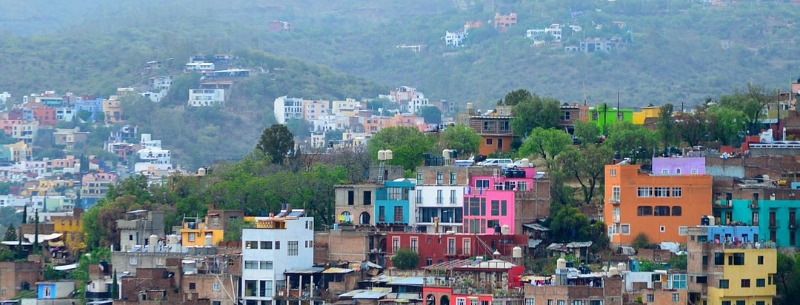Guanajuato – the Most Beautiful City in Mexico
Adventure awaits in the unique and romantic colonial city of Guanajuato, Mexico. From classic European performing arts theaters to grand museums of natural history and heritage, Guanajuato offers charm and refinement with a hint of Old World style.
Guanajuato is an incredibly charming city, as is immediately apparent upon entering through its subterranean main street. The street follows the original course of the Guanajuato River, running for nearly 3 km beneath the city.

Yet the real attraction to this unusual city isn’t in the colonial architecture of it’s interesting buildings, or the spacious parks that offer quietness and peace. The real strength of the city lies beneath your feet.
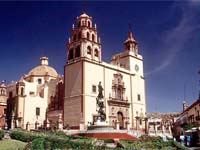 The city is famous for its subterranean main street, its Museo de las Momias (museum of the mummies), and the historical ruins of a city that stands beneath the existing city, destroyed by floods and now partially unearthed and shadowed beneath the ground. It is a city of alleyways and plazas, silver mines, history and culture.
The city is famous for its subterranean main street, its Museo de las Momias (museum of the mummies), and the historical ruins of a city that stands beneath the existing city, destroyed by floods and now partially unearthed and shadowed beneath the ground. It is a city of alleyways and plazas, silver mines, history and culture.
Welcome to Guanajuato – a strange city of charm and romance; where ghosts walk the streets of the city-beneath-the-city, a destination lost in time and space; a city known at one time as the richest silver mining center in the world.
The city sits in a valley surrounded by semi-arid hill country. The nearby Sierra de Guanajuato mountains are tree-covered and offer plenty of outdoor adventure opportunities.
But so great is the charm and mystery of the city, it’s doubtful you’ll wander far for long. The city is made to explore by foot, not car, and every corner provides a subtle change in architecture, environment, and appeal.
Guanajuato’s name originates from the word Quanax-juato which, in the indigenous dialect of the region, meant “Place of Frogs” – because the indigenous tribes thought the place was fit only for frogs!
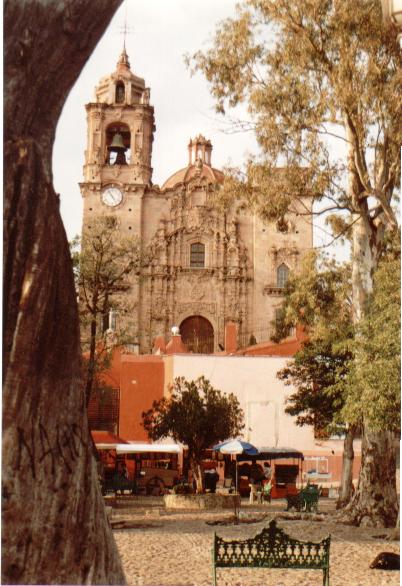 Little could they have known that the Spanish would later find rich veins of silver and extract from them vast fortunes to build a magnificent city and such beautiful churches as Iglesia de San Cayetano (or Valenciana, built between 1765 and 1786) on the outskirts of the city.
Little could they have known that the Spanish would later find rich veins of silver and extract from them vast fortunes to build a magnificent city and such beautiful churches as Iglesia de San Cayetano (or Valenciana, built between 1765 and 1786) on the outskirts of the city.
The Valenciana mine located here was one of the richest silver finds in history. In the 18th century this one mine alone accounted for 2/3 of the world’s silver production.
Explore the links below to discover more about this great alternative destination and how it just might fulfill your adventuresome fantasies of a place out of time, a unique adventure destination.
Guanajuato Attractions
Guanajuato is famous worldwide for many things, but there are mainly three principal attractions for the common tourist:
- Its mines, like Valenciana, Cata, Rayas and so on, many of which are open to the public.
- The cemetery museum, where you can see mummified corpses created by the mineral action of the special soil of this place, and
- The Internacional Cervantino Festival, or FIC, a very important and famous festival plenty of culture, music, theatre and dance, which is held every year on the first two weeks of October and that draws artists and tourists from around the world.
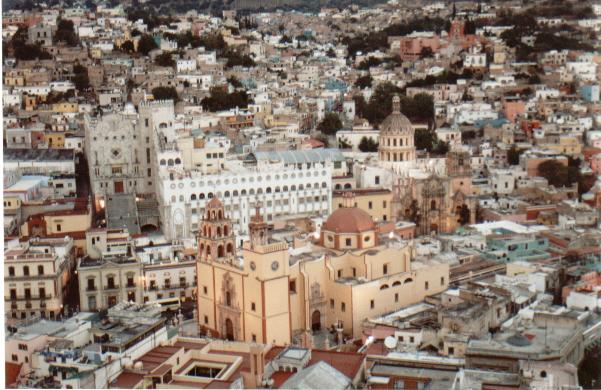 There are several legends here in Guanajuato regarding to those rooms and hidden passages, forgotten for all but for the old ghosts. One of those legends tells of the old musician who was hired by the devil to play on an elegant underground room, or the ghosts of old monks who walk silently on the buried rooms and cells of the old San Diego monastery, or the local version of the Weeping Woman, which popular belief says can be seen on the tunnels bound to Alonso Street and Union Park.
There are several legends here in Guanajuato regarding to those rooms and hidden passages, forgotten for all but for the old ghosts. One of those legends tells of the old musician who was hired by the devil to play on an elegant underground room, or the ghosts of old monks who walk silently on the buried rooms and cells of the old San Diego monastery, or the local version of the Weeping Woman, which popular belief says can be seen on the tunnels bound to Alonso Street and Union Park.
- Guanajuato has been the seat of the Festival Internacional Cervantino, that has been held every year since 1972.
- The Municipal Graveyard, famous because of the natural mommification of many of the corpses buried there, has been used for more than 100 years. On the late 1950s, it was enlarged and embelished, creating three new wings full of niches for the new “tenants”.
- For many years, the better way to arrive to Guanajuato was by railroad, which used to arrive at the old station located on the Tepetapa colony. But for almost five years, the railroad doesn’t arrive to Guanajuato anymore, because today is easier and faster to get here by car using the modern freeways.
Underground Street
The famous Underground Street, formally known as Miguel Hidalgo Street, was inaugurated on the late 1950s. It follows the bed of the old Guanajuato river, that used to run in the middle of the city.
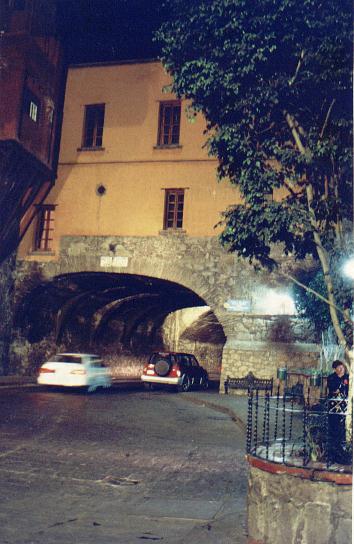
The Underground Street was built with three objectives in mind: Create a new causeway to disentangle the traffic in downtown Guanajuato, sanitize the city by covering the old sewer river that used to run on the surface, and give Guanajuato a very unusual street that could be considered one of its most interesting attractions.
In 1976 the last drainage tunnel was finished, and ever since Guanajuato has been free of the constant floods that used to cover it.
Teatro Juárez
Every year, Guanajuato hosts the International Cervantino Festival, named after Miguel de Cervantes, the author of “Don Quixote.” Recitals, concerts, plays, ballet, modern dance, opera, and art exhibits feature artists from all over the world. Events are held throughout the city, as well as in other cities throughout Mexico, including Mexico City, Guadalajara, and San Miguel de Allende.

The true focus of the festival, however, is the Teatro Juárez (1903, above), which faces Guanajuato’s main plaza, el Jardn de la Unión. Every bit of the theater’s interior is sculpted, painted, carved, or embossed in a stunning, truly breathtaking display of period art.
Plaza de Baratillo
There is a multitude of plazas and plazuelas in Guanajuato’s core, giving it a distinctly European flavor unlike that of any other Mexican city. Walking around the city reveals something new at every turn of the corner.
Accidental Mummies of Guanajuato
The Guanajuato mummies were discovered in the Guanajuato cemetery, which is located northwest of Mexico City (near Léon). They are unintentional modern mummies, literally “dug up” between 1865 and 1958 when a local law required relatives to pay a kind of grave tax. You could pay the tax once and be done with it (170 pesos); this option may have appealed to wealthier individuals. However, you could pay a yearly fee of 50 pesos, which would have appealed to less wealthy families. If the relatives were unable to pay the yearly tax for three years, the body (which had become accidentally mummified) was dug up from the cemetery and (if the fee was still not paid) displayed in El Museo de las Momias. [Of course, what if the person’s family had moved out of town, or if the person was the last member of their family? It didn’t matter because the law was the law!]
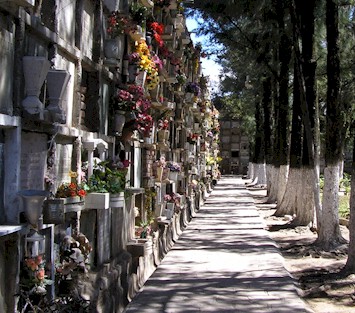 Fortunately, the law was changed in 1958. Despite the fact that no new bodies have been discovered, the museum still displays the original mummies.
Fortunately, the law was changed in 1958. Despite the fact that no new bodies have been discovered, the museum still displays the original mummies.
According to an article published in the Arizona Republic on November 1, 2005, the mummies first drew tourists in the early 1900s “when cemetery workers began charging visitors a few pesos to enter the ossuary building, which housed bones and mummies. But it wasn’t until the 1970 film Santo Versus the Mummies of Guanajuato, starring masked wrestler Rodolfo Guzmán Huerta, that business really took off.”
NOTE: The first mummy was discovered on June 9, 1865, by Dr. Remigio Leroy. The museum first opened its doors in 1894.
How were they made
The bodies in the local cemetery dried out naturally due to a combination of soil conditions and the dry climate of the mountainous area. The bodies were placed in seven-row tombs; those in the middle row were apparently more likely to have been naturally mummified. However, only those who did not pay the grave tax were ever exhumed, so knowledge of mummification will always be limited.

How many were made
No one knows how many mummified bodies were removed from the crypts, but when I visited Guanajuato’s mummy museum, I found 119 mummies on display. Many other natural mummies may be lying in the cemetery…but no one will ever know because the law has been changed.
What’s special about them
The mummies in Guanajuato are among the strangest ever displayed. Some are dressed, while others are not. Some people are only wearing socks and/or shoes. Some are elderly, while others are only infants. One tiny baby mummy is labeled “La momia más pequeo del mundo”—the world’s smallest mummy. The baby and the mother (who died during a caesarean section) are both in the museum, but not together.
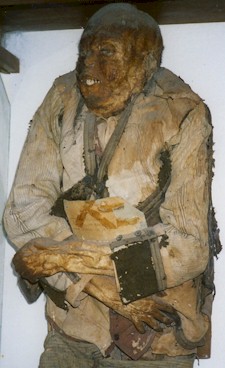 There are also a few local legends in the museum. One body, for example, was said to be that of a woman who had been buried alive. When the Mummy Road Show hosts investigated the mummy, they came to the conclusion that two factors indicated that the legend was true: the woman’s arms were raised over her face, and her forehead had scratch marks.
There are also a few local legends in the museum. One body, for example, was said to be that of a woman who had been buried alive. When the Mummy Road Show hosts investigated the mummy, they came to the conclusion that two factors indicated that the legend was true: the woman’s arms were raised over her face, and her forehead had scratch marks.
Should they still be displayed, given the circumstances of their exhibition? Or would it be more appropriate to plan a dignified and respectful burial? Or have the mummies become a necessary part of the town’s budget? They contribute significantly to the town’s tourism revenue, as nearly a million visitors visit Guanajuato each year to see the mummies.
Where to see them
The Guanajuato mummies can be seen at the Museo de las Momias, which is located on a hill overlooking the city. The nearest airport (about 45 minutes away) is Léon, or you can take a bus from Mexico City. There is no longer a train service from Mexico City.
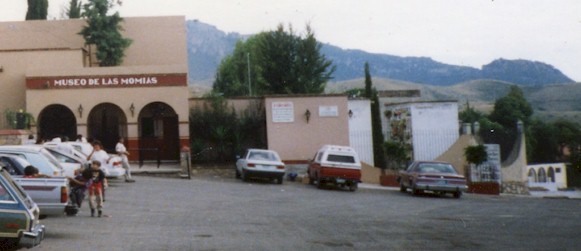
Regular tour buses arrive. Although you may not learn much about the lives of the mummies, you will most likely learn a lot about the people who come to visit them if you ever go on a mummy trip to Mexico.
Guanajuato Mummies: Gallery
Here are some of the more famous Guanajuato mummies:
1. Ignacia Aguilar, who may have been buried alive. When the hosts of National Geographic’s Mummy Road Show visited the museum for the Halloween 2002 episode, they concluded that two factors suggested this legend was correct: the woman’s arms were raised over her face and her forehead had scratch marks:
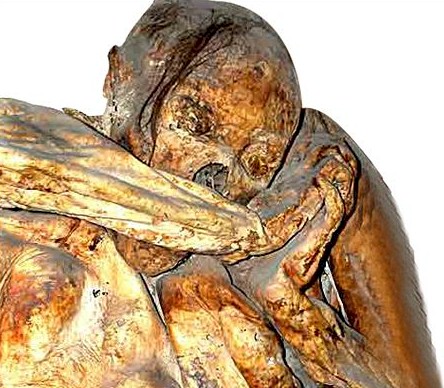
2. Juan Jaramillo, the best preserved of the Guanajuato mummies:
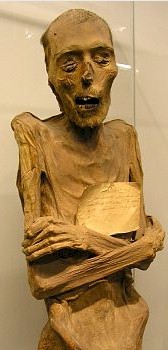
3. Gabino Castro who was buried in 1904 with an identification.
4. One head that reportedly belonged to a robber.
5. Two unidentified women, one who died at an old age and one who is wearing socks (some of the mummies are unclothed):

6. Four children, including Magdalena Aguilar:

Another child was Nino Gorro:
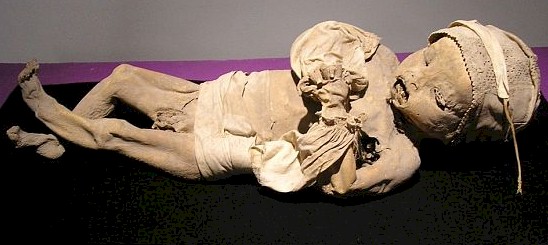
My thanks to Patricia Rodriguez of the Museo de Historia Mexicana in Monterrey, Mexico, for providing these photographs. These mummies were exhibited at the museum in September and October, 2006.
Getting There
You can drive to Guanajuato from either Guadalajara or Mexico City. From either place, it will take you no more than four hours to get to this crazy place, seat of the Government of the state. In Guanajuato you will also find the famous Universidad, institution whose history is closely interwoven with the famous and traditional Estudiantinas and Callejoneadas.
